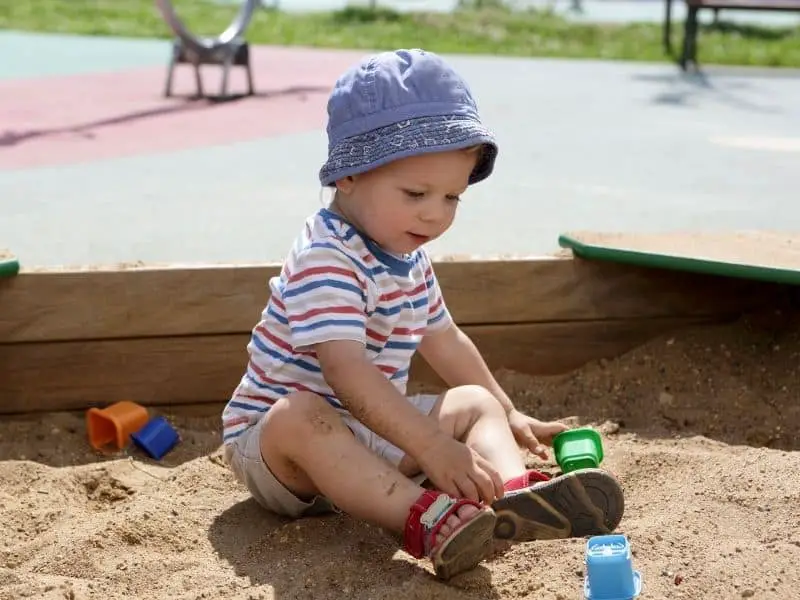Sandboxes are attractive prospects for kids. Whether at the public park or in your own home, a sandbox can be a source of hours of entertainment and learning for your kids. Besides that, many of us have fond memories of playing in sandboxes when we were kids, and we’d like for our kids to make those memories, too. But, there is one common question that parents around the world ask, and it’s the question of sandbox cleanliness.
In general, sandboxes are not sanitary. They’re often filled with germs, bacteria, and parasites that can make our children sick including Toxocara, Ascaris, and pinworms. While infections from these parasites often go unnoticed, they can produce severe symptoms in certain individuals.
Of course, this doesn’t mean that we should ban our kids from playing in the local sandbox! We should, however, be aware of the risks and take precautions to keep our children safe. In this article we’ll share with you what you need to know about sandbox cleanliness and what steps you can take to keep yours clean.
The Risks of Sandboxes
There have been several studies highlighting the bacteria found in sandboxes. A 2008 study found that sandboxes were even dirtier than public restroom handles. And we’ve all seen someone come out of a stall to the sound of a flushing toilet and walk straight out of the restroom. Yuck!
But, there are germs everywhere, and kids get into them no matter what. That’s the nature of being a kid. And some argue that it’s important for building immunities.
But, there are some other things to consider. A few studies have found harmful parasites present in public sandboxes around the world. For the most part, these parasites cause relatively minor symptoms — if any at all. But there are extreme cases of more serious issues. If you’d like to read more about it, check out this Slate article.
Take Precautions at Public Sandboxes
Most of the studies mentioned above took samples from public sandboxes. This is important to keep in mind. A little common sense will tell you that sandboxes in public parks and at daycare centers don’t usually get cleaned or covered. They’re exposed to dozens, if not hundreds of kids, and who knows how many animals. So yeah, they’re pretty dirty. It’s to be expected.
Here’s what you can do to reduce the risk of illness if your kids play at a public sandbox:
- Don’t allow your kids to put any sand in their mouths. Keep their hands out of their mouths, too, if possible.
- Wash their hands as soon as you can afterwards.
- Check the sandbox for foreign material before you let them play in it.
- If the sandbox smells bad, don’t allow them to play in it.
- Wash any toys they played with in the sandbox.
(If you’re worried about outdoor sandboxes, try one of these water tables. They work well with sand, as well, and you can keep them inside when they’re not in use.)
How to Keep Your Home Sandbox Clean
Honestly, I wouldn’t blame you if you didn’t let your kids play in public sandboxes at all. This is fairly reasonable. But a sandbox at home is a different story. With proper precautions, you can be confident that your own sandbox is fairly clean. Of course, no sandbox will ever be germ free. Nothing is germ free. But, with the tips to follow, you can enjoy some peace of mind while your kids play in your own private sandbox.
A Common Sense Approach to Keeping Your Sandbox Clean
If you have a sandbox at home, or you’re thinking of getting one, I’ve got the tips for you. Follow these guidelines as close as you can (or as close as you see fit) to ensure that your home’s sandbox isn’t a petri dish of bacteria and parasites.
1. Use a Cover
This is one of the most important factors to keeping a sandbox clean. Without a cover, you just don’t know what’s going on in your sandbox when it’s not in use. There could be crazy parasite parties raging in there all night. Cats could be rolling through and thinking “this is the best bathroom ever!”
Dogs could be coming around saying, “a cat left me a treat here!” Gross.
So, get a sandbox with a cover, like this one, or make a cover. You can use a tarp or wood with non-toxic sealant. The cover doesn’t have to be airtight. It just needs to keep animals and insects out of the sandbox. This is a big help in keeping the sandbox clean.
2. Keep The Pets Out
This is kind of what the cover is for when the sandbox is not in use. But, you kids may want to play with the dog or the cat or rabbit or mongoose in the sandbox. Avoid this if you can. Even during playtime, animals may be tempted to use the soft, enticing sand as a restroom.
3. Rake it Often
Even if you do keep a cover on the sandbox, make sure the pets stay out of it during playtime, and supervise your kids while they’re playing, some strange stuff is sure to end up in the sandbox. That’s why raking it often is a great idea. It will allow you to find any pieces of large debris that have made their way into the sandbox.
4. Watch out for Runny Noses/Diapers
When you use a cover on your sandbox, you can expect it to be fairly clean. At least, clean for a big box of sand. But, as parents we often think about germs coming into the sandbox from other sources. We don’t often think of the germs coming from our children. But, they do. So look out for runny noses and leaky diapers. If you do happen to catch a leaky diaper a little late, don’t stress about it. Just follow the next step to clean the sand and you’ll be good to go!
5. Clean the Sand Regularly
Believe it or not, you can clean and sanitize a sandbox. I’m not saying it will be completely free of bacteria once you’re done, but it will definitely be cleaner. Here’s a couple of different ways to do it:
- Rake the sand first, removing any debris, toys, etc.
- Mix 1 part bleach with 1 part water in a spray bottle
- Spray the top layer of sand with the bleach/water combination
- Mix the sand around with your rake or a shovel and spray again
- Repeat 3 to 5 times
- Let the sand dry completely before allowing kids to play in it again
If you don’t want to use bleach, you can use vinegar and water instead. If your sandbox sees a lot of use, clean the sand several times a year. If it only gets occasional play, twice a year should work (provided you use a cover).
6. Replace the Sand
At a certain point, cleaning the sand just won’t cut it anymore. This is why it’s important to replace the sand in your sandbox on occasion. For the average home sandbox, you only need to do this once every 2 years or so. But if your sandbox is a favorite of neighbor kids and gets a lot of use, you may want to replace the sand once a year.
Make sure to get safe play sand and not all-purpose or builder’s sand. Ideally, you’ll want sand that doesn’t have a lot of dust and doesn’t include tremolite and crystalline silica.
7. Other Common Sense Sandbox Tips
Here are a few other tips to keep your sandbox clean and safe:
- Plant insect-repelling plants around the sandbox. These include:
- Mint
- Basil
- Rosemary
- Lavender
- Citronella
- Wash your children’s hands and toys after they play in the sandbox.
- Try to keep your children from putting sand in their mouths.
- Replace the sand if it smells bad and cleaning it doesn’t help.
(You Might Like the Article: Best Outdoor Toys for Kids)
In Conclusion
Sandboxes are not sanitary and they never will be. That said, the risk of your child catching a serious bug from a sandbox is pretty low. You may want to keep away from public sandboxes if you’re worried about bacteria. A home sandbox can be a great place for your children to have fun while learning fine motor skills.
With a little bit of foresight and the common sense tips for keeping your sandbox clean that I listed above, you can let your kids enjoy a sandbox without worrying about it having more germs than it has grains of sand.
Thanks for reading!

